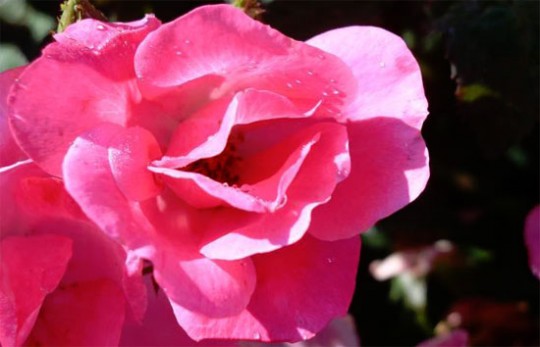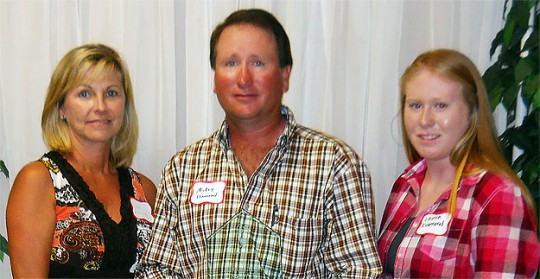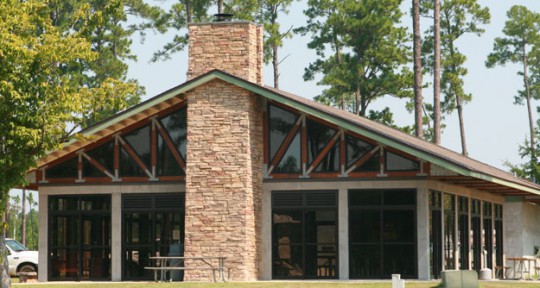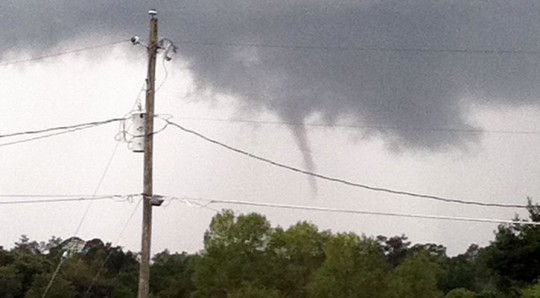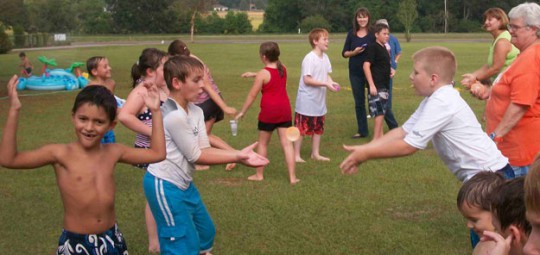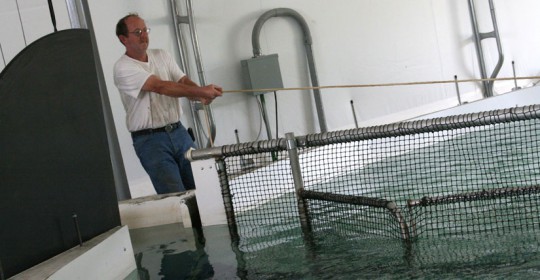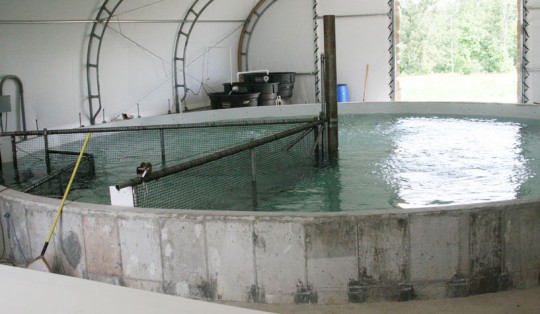Weekend Gardening: Prune Roses Now For Fall Flowers
September 24, 2011
 Rose flowering and overall performance aren’t great during our Gulf Coast summers, but each year we have the potential to have great fall blooms due to the cooler conditions and typically drier weather.
Rose flowering and overall performance aren’t great during our Gulf Coast summers, but each year we have the potential to have great fall blooms due to the cooler conditions and typically drier weather.
Although we should have pruned our rose bushes back in early spring, they have been growing since then, and many may look overgrown, leggy and less attractive now. That’s particularly true with the popular hybrid teas and grandifloras.
So a second, less severe pruning is recommended in early September to get rose bushes in shape for the fall blooming season.
First, all the dead growth should be removed. Make your cuts well into the healthy part of the canes just above a leaf or dormant bud – or remove the dead cane entirely back to its point of origin.
Next, remove weak, spindly canes the diameter of a pencil or less, particularly those growing in the interior of the plant. Cut them off at their point of origin, making sure you do not leave a stub. If you see any sprouts originating from the root stock (below the large, knobby graft union), cut them off, too. Do not remove any strong new shoots growing from the graft union, however.
The major part of the pruning involves shortening the remaining vigorous canes. This will produce a fuller, more attractive bush with larger, better quality flowers in October. This pruning needs to be done even if there are flowers on the bush now.
Cut the canes back to about 24 to 30 inches from the ground. Ideally, try to make each cut just above a bud that faces outward (away from the inside of the bush). The cuts should be made about one-fourth inch above the bud at a slight angle slanting away from the bud. Don’t leave a large stub sticking up above the bud or you will encourage stem rot, and don’t cut too close to the bud or you will kill it.
Clean up and dispose of all leaves and prunings from the area. Then fertilize the roses to encourage vigorous new growth. Use your favorite rose fertilizer following label directions or use a general-purpose fertilizer appropriate for your area.
 Ever-blooming old garden roses, shrub roses, landscape roses and other groups also may be pruned now, but the pruning required generally is less severe and is done mostly to shape the bush or to control the size of more vigorous cultivars. Use your best judgment when it comes to pruning these roses.
Ever-blooming old garden roses, shrub roses, landscape roses and other groups also may be pruned now, but the pruning required generally is less severe and is done mostly to shape the bush or to control the size of more vigorous cultivars. Use your best judgment when it comes to pruning these roses.
Some roses – including many climbing roses, ramblers and old roses – only bloom once in spring and early summer. They should not be pruned back now, since they will produce flowers next year on the growth they made this summer. Cutting them back now or anytime before they bloom next year will reduce the number of flowers they produce.
Pruning is a job that many gardeners approach with apprehension. There is always a fear that if it’s not done correctly dire things may happen to a plant. With some exceptions, pruning shrubs is more like getting a haircut. Even a really bad haircut eventually will grow out and look better.
Theresa Friday is the Residential Horticulture Extension Agent for Santa Rosa County.
Museum Dedicates Nixon’s Marine One (With Gallery)
September 23, 2011
 National Museum of Naval Aviation in Pensacola official dedicated the “Marine One” helicopter Thursday that was used to transport Presidents Nixon and Ford. The helicopter has been on display in the “Hanger Bay One” building at the museum and now it’s official open to the public.
National Museum of Naval Aviation in Pensacola official dedicated the “Marine One” helicopter Thursday that was used to transport Presidents Nixon and Ford. The helicopter has been on display in the “Hanger Bay One” building at the museum and now it’s official open to the public.
The aircraft is one of just three or four used to transport Nixon and Ford, including Nixon’s famous goodbye from the lawn of the White House after his resignation in August 1974.
Pictured: Marine One at the National Museum of Naval Aviation in Pensacola. NorthEscambia.com photos, click to enlarge.
Molino Park Students, Parents Swap Clothes
September 23, 2011
The Molino Park Elementary School PTA held a clothing swap Thursday, giving PTA members the chance to swap their unwanted clothing for free clothing from other parents. Organizers said it was a chance for the PTA to serve the community. Pictured: Tables of clothing ready for a free swap at Molino Park Elementary. Submitted photo for NorthEscambia.com, click to enlarge.
Diamond Named Northwest Florida Agricultural Innovator of the Year
September 22, 2011
Farmer Mickey Diamond has been recognized as the “Northwest Florida Agricultural Innovator of the Year”. Diamond was chosen from a select group of nine County Ag Innovators across Northwest Florida who have contributed to the efforts of the Extension Service and have made a difference to agriculture in the region, and to their community.
Diamond is a third generation farmer who began farming with his father in 1984. The Diamond farm near Jay has grown from 125 acres in its first year to well over 1,700 acres today. The family’s major crops are cotton and peanuts but they also produce wheat, hay, timber, and soybeans.
Family members and neighbors help sustain the farm. Diamond’s wife Lisa, a full-time nurse, assists whenever she can. During the fall harvest season, she operates the cotton module builder, hauls peanut wagons and drives a tractor. His 17-year old daughter Lauren helps out after school. A key component of his approach to farming involves sharing work with fellow growers with whom he performs custom planting and harvesting to pool equipment and labor.
According to the Extension Service, Diamond is a progressive businessman who looks for better ways of doing things. He quickly analyzes and adopts the latest technology that will be profitable for his farming operation. He is committed to protecting the environment through the use of conservation and best management practices. In 1995, he was one of the first farmers in the county to try strip-tillage. Other farmers were impressed with how his soil held moisture during dry weather. They also liked the benefits gained from less wind and water erosion, while reducing costs. As a result, Santa Rosa County growers have led the state for many years in the adoption of conservation tillage.
In 1995, Diamond was one of the first farmers in the state to plant a demonstration plot of BT cottonseed. That season bollworms caused severe crop loss throughout the county but damage was minimal in his test field. Within two years over 85 percent of cotton in the county was planted to BT varieties and insecticide applications for bollworms decreased from an average of 10 to 15 per season to less than two.
Diamond was also one of the first farmers in the area to incorporate precision agriculture technology into his operation. He began with grid soil sampling and variable-rate lime application in 1998. That first year he saved 29 tons of lime on a 56-acre field. The next year he only needed to apply lime to 40 acres out of 750. Because of the results on his farm, others quickly adopted the technology and today many growers in the county employ precision technologies such as variable-rate lime and fertilizer application, field mapping, and GPS equipment guidance for field operations.
Diamond has worked closely with the IFAS Extension and Research faculty for many years. He currently serves on both the Santa Rosa County Extension Agricultural Advisory and the WFREC Advisory Committees. He served over 20 years as a board member and officer of the Santa Rosa Pest Management Association, Inc. to offer pest management scouting services to local farmers.
He has offered his farm as the site for numerous Extension demonstrations. Since 1990 he has annually participated in large-plot cotton variety demonstrations. Others have included those involving cotton nematicides, insecticides, plant growth regulators, peanut varieties and fungicides, and conservation tillage methods.
Diamond was one of the first local growers to adopt “on-farm peanut pod blasting” for determining peanut maturity. In 2008, he hosted a grower demonstration at his farm. As a result, many area growers now use the procedure. He is often the “go to Extension cooperator” in the county because of his progressive attitude; desire to serve the community, and meticulous attention to detail in all aspects of his operation.
Each year he has hosted several tours of his farm for various groups including growers, industry personnel, chamber of commerce members, school classes, and 4-H youth. He has also helped with the Annual Santa Rosa County Farm Tour for many years with tour stops, grower panels, by serving refreshments, or in whatever capacity needed. During the 1995 Farm Tour he received the Outstanding Farm Family of the Year award.
Diamond, according to the Extension Service, has invested his time, talents, and resources to improve and promote agriculture. He has been a spokesman for farmers at the local, state, and national levels. Through his involvement with Farm Bureau he has made numerous trips to Washington and Tallahassee to talk with elected officials about agricultural concerns and issues. He has made a difference to agriculture and his community in many other ways, especially through his service to various organizations and boards.
Pictured top: (L-R) Lisa, Mickey and Lauren Diamond. Submitted photo for NorthEscambia.com, click to enlarge.
Lake Stone Pavilion Will Get A/C
September 22, 2011
The pavilion at Lake Stone will soon be a much “cooler” place for events; air conditioning will be added to the pavilion in the next few weeks..
The pavilion is located at the Lake Stone Campground, a 100-acre campground and boat ramp facility on Highway 4 west of Century. The campground has 77 campsites available for rent on the shores of the freshwater lake.
The Lake Stone pavilion or campsites can be reserved by calling the Lake Stone campground manager at (850) 256-5555 or Escambia County Parks and Recreation at (850) 475-5220.
Pictured above: The pavilion at Lake Stone will soon air conditioned. NorthEscambia.com photo, click to enlarge.
Caught On Camera: Weak Funnel Cloud In Molino
September 21, 2011
A NorthEscambia.com reader took these photos Wednesday afternoon in Molino showing what the National Weather Service said appeared to be a very weak funnel cloud. The photos were taken near Fairground Road and the Escambia River.
“It may be a funnel cloud,” said Don Faulkner, meteorologist with the National Weather Service Office in Mobile said. “We think that it may have spun up on the shear zone along the sea breeze possibly as a waterspout over the bay and maintained its mid level structure as it moved inland. Atmospheric conditions were not conducive for tornado development but it is unstable enough for waterspouts and brief funnel clouds.”
If you have weather photos, email them to news@northescambia.com
Submitted photos for NorthEscambia.com, click to enlarge.
Facebook Changes: Many Local Residents Are Not Happy
September 21, 2011
Facebook, the world’s most popular social media site with thousands of local users, has made changes for most users, and many North Escambia area users are not happy about it.
The big change is in the news feed — it no longer appears in just chronological order but is displayed based upon what Facebook sees as the most important based upon each person’s viewing habits.
Facebook explained it like this on their blog:
“When you pick up a newspaper after not reading it for a week, the front page quickly clues you into the most interesting stories. In the past, News Feed hasn’t worked like that. Updates slide down in chronological order so it’s tough to zero in on what matters most.
Now, News Feed will act more like your own personal newspaper. You won’t have to worry about missing important stuff. All your news will be in a single stream with the most interesting stories featured at the top. If you haven’t visited Facebook for a while, the first things you’ll see are top photos and statuses posted while you’ve been away. They’re marked with an easy-to-spot blue corner.”
 There’s also a new real-time news ticker that is designed to make it easier to join conversations.
There’s also a new real-time news ticker that is designed to make it easier to join conversations.
Facebook said: “Ticker shows you the same stuff you were already seeing on Facebook, but it brings your conversations to life by displaying updates instantaneously. Now when a friend comments, asks a question or shares something like a check in, you’ll be able to join the conversation right away. Click on anything in ticker to see the full story and chime in – without losing your place.”
But the new changes are not sitting well with many local Facebook users. On our NorthEscambia.com publisher’s Facebook page, users have expressed their displeasure. Here’s a sampling of the comments:
- “Don’t like it. What was wrong w/ the original????” – Teresa Andress, Molino
- “I am confused; not good” — Diane Lowery, Cantonment
- “Do not, do not like this new Facebook…Why not leave FB alone” – Sue Smith, Uriah, Ala.
- “I DO NOT!! Like the new facebook!!!” — Caitlin Roley-Lovely, Bratt
- “I don’t like it…it confused me” – Kimberly McCullough, Walnut Hill
- “Uncalled for” – Rhonda Pridgen, Flomaton
- “Huge dislike” – Dorreen Allen, Cantonment
- “I do NOT like…’If it ain’t broke, then it don’t need to be fixed’” – Alan Bell, Atmore
- “Seeing double here… looking at homepage and news then over to right is same thing…. annoying for sure” – Tricia Chastain
- “The mobile version is very annoying!!!! Don’t like at all” – Mandy Odom, Century
A few people have also expressed cautious optimism about the Facebook changes:
- “Give it a week and you’ll forget it was ever different” – Clint Davis, Walnut Hill
- “I’m not really crazy about it, but I’m addicted to FB so I will just relearn how to use this new format. By the time I get used to this format, they will change it to something else.” – Tamara Smith, Century
- “I’m not loving it yet… maybe when I figure it out!” – Beth Norwood, Flomaton
To join in our Facebook conversation about Facebook, head over to Publisher William Reynolds’ Facebook page at:
https://www.facebook.com/northescambiaWilliam
You can also “Like” the NorthEscambia.com Facebook page at:
https://www.facebook.com/NorthEscambia
Free Hunter Safety Course Offered
September 19, 2011
Escambia County Extension Services and the Florida Fish and Wildlife Conservation Commission are offering a free hunter safety course at the Langley Bell 4-H Center, 4810 West Nine Mile Road.
Classes will be held from 6:00 p.m. to 9:00 p.m. on September 20th, 22nd, 27th, and 29th with the range portion held October 1st from 7:00 a.m. to 10:00 a.m. Both traditional classroom style and online training are available.
The traditional hunter safety course, which covers the knowledge, skills, and ability needed to be a safe hunter, is 12 hours of classroom instruction with a test and three hours on the range.
The online version allows students to learn a majority of the course via computer with the remainder of the course covered in a four-hour classroom session on September 20th, followed by a test, and three hours on the range on October 1st.
Anyone born on or after June 1, 1975, must complete a hunter safety course before purchasing a hunting license.
Participants must be 12 years of age or older. Children under 16 must be accompanied by an adult at all times. Each person must be pre-registered.
Information and registration is available online at http://myfwc.com/hunting/safety-education or by calling the FWC’s regional office in Panama City at (850) 265-3676 or
by calling Libbie Johnson at Escambia County Extension Services, (850) 475-5230 or email libbiej@ufl.edu.
Molino Kids Celebrate With Back To School Blast
September 19, 2011
Aldersgate United Methodist Church in Molino held a “Back to School Blast” Sunday afternoon. Children from across the community enjoyed fun and games, and there was a family cookout for people of all ages. The church also collected reams of paper to benefit Molino Park Elementary School.
For more photos from the event, click here.
Do you have news from your church or community group? Email your photos and information to news@northescambia.com.
Submitted photos for NorthEscambia.com, click to enlarge.
Walnut Hill’s ‘The Tank’ Named 2011 Ag Innovator
September 18, 2011
The Escambia County Extension Service has named “The Tank” in Walnut Hill as the 2011 Ag Innovator for Escambia County.
Vernon Hiebert has been a catfish producer in Escambia County for more than 15 years, but after several years of depressed prices and increasing production costs, he decided that he needed to do something drastically different if he wanted to keep his enterprise afloat.
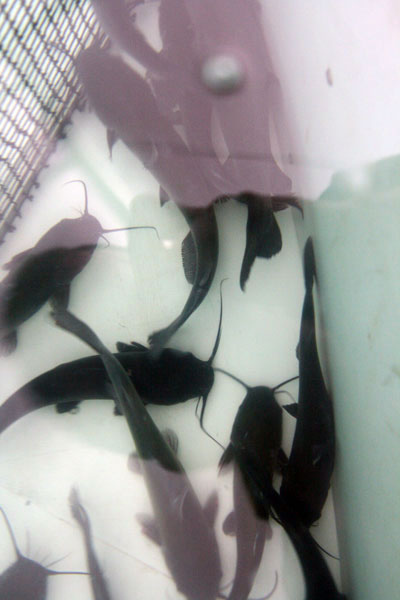 The prices he was receiving for his live fish at the catfish processing plant were not keeping pace with his costs, but the demand for catfish was increasing. He decided to direct market his product locally to individuals and eventually stores and restaurants by building The Tank — a 32-foot wide indoor pool that can hold up to 20,000 catfish at a time.
The prices he was receiving for his live fish at the catfish processing plant were not keeping pace with his costs, but the demand for catfish was increasing. He decided to direct market his product locally to individuals and eventually stores and restaurants by building The Tank — a 32-foot wide indoor pool that can hold up to 20,000 catfish at a time.
The Tank, Hiebert says, offers the freshest tasting catfish anywhere—none of that musky flavor that makes catfish taste “off.”
He seines fish from one of his production ponds each Monday and brings 800–1200 lbs of live fish into the Tank. The water in the tank is recycled; it goes through a three-stage filter system ensures the freshest water. The fish have three days to purge themselves in the clean water, removing impurities that might cause off-flavor.
The round indoor tank uses a system of fences to contain fish to a certain part of the pool, or move them toward an electric “elevator” that lifts them out of the water. Shoppers can take the fish home whole or have them dressed, or cleaned. He has standing orders from one high end grocery store in Pensacola and several seafood restaurants that are happy to offer a local freshwater fish choice on their menus.
Hiebert is a huge supporter of Escambia County Extension. During their 2010 Farm Tour, he hosted 120 visitors to The Tank and offered each person samples of his fish prepared by frying and by grilling. Before the stop, several people said that they were interested in learning more about catfish product but not in eating any of the samples because he or she didn’t like catfish. Most of the naysayers changed their tune once they were coaxed into trying the fish by Hiebert.
His innovative business has been instrumental in helping Escambia Extension with a major part of its clientele — local consumers. Hiebert’s operation is in the heart of Walnut Hill—the center of Escambia County agriculture. His business draws people to North Escambia where people can see local agriculture and purchase locally grown fruits and vegetables.
Local agritourism has great potential in an area like Escambia County that has a large local and tourist population, and The Tank is a great way to get people out of the city and into the areas where farmers can sell directly to the consumers, according to the Extension Service.
Escambia County’s one thriving catfish industry is down to three producers — one of which sells only to processing plants, one who markets to plants and has a fee fishing operation, and Hiebert’s The Tank.
Pictured top: Vernon Hiebert corrals catfish at The Tank in Walnut Hill. Pictured inset: Catfish in the crystal-clear waters of The Tank. Pictured below: The Tank can hold 20,000 catfish. NorthEscambia.com photos, click to enlarge.


